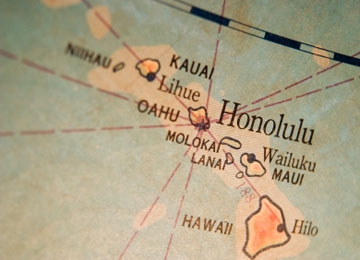 Hawaii Weighs Undersea Cable to Deliver Wind PowerJun 23, 2010 - Katherine Tweed - greentechmedia.com Hawaii needs to carry wind across an ocean to meet its renewable energy goals. Hawaii faces the same renewable energy
problem as the mainland: The resources are in Hawaii is looking to deliver nearly 400 megawatts of energy from wind farms on sparsely populated Molokai and Lanai to the most populous island, Oahu, via an undersea transmission cable to help meet the state's ambitious clean energy goal of 70 percent renewables by 2030. The cable project is two-fold; it involves building two large wind farms across more than 12,000 acres and then laying down the cable to deliver the energy. One cannot happen without the other, yet it is far from a sure bet. The plan is currently undergoing environmental assessments, although "we don't see anything that's a showstopper on the ocean floor," after initial assessments, according to Joshua B.Y. Strickler, a facilitator of Renewable Energy Programs with Hawaii's Clean Energy Initiative, which is lead by Hawaii's Department of Business, Economic Development and Tourism. Currently they are looking at the impact of the cables and the wind farms themselves, as well as finding the right benefits package for the affected communities. The inter-island cable project would not be the first cross-sea cable. Long Island, NY, for example, currently has 300 MW of power delivered across the Long Island Sound from Connecticut. This would be the first undersea transmission cable specifically built to carry renewable energy, however. On land, there are other transmission cables being built specifically for renewables, such as the Tehachapi Renewable Transmission Project in California. If the cable in Hawaii comes to fruition, there is also talk of eventually linking the cables to Maui. While NIMBY -- not in my back yard -- attitudes are still an issue around the proposed wind farm areas, especially on Molokai, the recent oil spill in the Gulf of Mexico has made some people think twice. Hawaii currently relies on imported oil for 90 percent of its energy needs. "[The spill] raised a lot of concerns for us statewide," said Strickler. "It has made people more willing to listen. Would you rather look at an oil spill or a wind farm?" However, it is not just community concerns that have mired the project in uncertainty. The cable alone is estimated to cost around at least $1 billion, so really it comes down to cost. So far, Strickler said that all of their models have found that investment would ultimately benefit ratepayers, but they will continue to crunch the numbers to see if it makes financial sense before moving forward. Bringing wind power on will also require updates to Oahu's power grid, but Strickler said the figures seem to make sense. He estimated that his department will have a decision on the initial phase of the project in the next six months. "It's a hedge against oil at the end of the day. Our bet in Hawaii is it's going to go up," said Strickler. "When the Saudis sneeze, we say gesundheit." This project is just one of many that Hawaii is toying with to meet their renewable goals and green their energy sources. Wave energy is hotly discussed, but rarely implemented because it faces many of the same engineering difficulties of tidal power. While everyone waits for the technology to catch up to the hype of wave power, Honolulu is also is working toward installing a massive seawater air conditioning system that could cut grid power consumption by 77 million kilowatt hours a year and eliminate the need to add 14 megawatts of peak capacity, according to Anders Rydaker, president of Ever-Green Energy, which will provide the technology for the system and own and manage it through a subsidiary once construction is complete. There are also plans for Pacific Power & Light to test out a small solar thermal plant. There are other plans as well, like 30 megawatts of wind on Oahu and of course, energy efficiency gains. But there is no clear Plan B to meet the state's renewable goals if the wind farms and undersea cable project fall through. For now, Strickler is optimistic, saying, "We can build this." |
Email this page to a friend
If you speak another language fluently and you liked this page, make
a contribution by translating
it! For additional translations check out FreeTranslation.com
(Voor vertaling van Engels tot Nederlands)
(For oversettelse fra Engelsk til Norsk)
(Для дополнительных
переводов проверяют
FreeTranslation.com )


 one
place but the people are in another. For the island
chain, however, there is one more confounding variable
-- the ocean.
one
place but the people are in another. For the island
chain, however, there is one more confounding variable
-- the ocean.